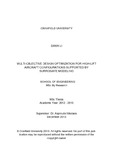JavaScript is disabled for your browser. Some features of this site may not work without it.
| dc.contributor.advisor | Nikolaos, Asproulis | |
| dc.contributor.author | Li, Daxin | |
| dc.date.accessioned | 2014-05-22T08:52:05Z | |
| dc.date.available | 2014-05-22T08:52:05Z | |
| dc.date.issued | 2013-12 | |
| dc.identifier.uri | http://dspace.lib.cranfield.ac.uk/handle/1826/8468 | |
| dc.description.abstract | Nowadays, the competition among airlines seriously depend upon the saving operating costs, with the premise that not to degrade its services quality. Especially in the face of increasingly scarce oil resources, reducing fleets operational fuel consumption, is an important means to improve profits. Aircraft fuel economy is determined by operational management strategies and application technologies. The application of technologies mainly refers to airplane’s engine performance, Weight efficiency and aerodynamic characteristics. A market competitive aircraft should thoroughly consider to all of these aspects. Transport aircraft aerodynamic performance mainly is determined by wing’s properties. Wings that are optimized for efficient flight in cruise conditions need to be fitted with powerful high-lift devices to meet lift requirements for safe takeoff and landing. These high-lift devices have a significant impact on the total airplane performance. The aerodynamic characteristics of the wing airfoil will have a direct impact on the aerodynamic characteristics of the wing, and the wing’s effective cruise hand high-lift configuration design has a significant impact on the performance of transport aircraft. Therefore, optimizing the design is a necessary airfoil design process. Nowadays engineering analysis relies heavily on computer-based solution algorithms to investigate the performance of an engineering system. Computational fluid dynamics (CFD) is one of the computer-based solution methods which are more widely employed in aerospace engineering. The computational power and time required to carry out the analysis increases as the fidelity of the analysis increases. Aerodynamic shape optimization has become a vital part of aircraft design in the recent years. Since the aerodynamic shape optimization (ASO) process with CFD solution algorithms requires a huge amount of computational power, there is always some reluctance among the aircraft researchers in employing the ASO approach at the initial stages of the aircraft design. In order to alleviate this problem, statistical approximation models are constructed for actual CFD algorithms. The fidelity of these approximation models are merely based on the fidelity of data used to construct these models. Hence it becomes indispensable to spend more computational power in order to convene more data which are further used for constructing the approximation models. The goal of this thesis is to present a design approach for assumed wing airfoils; it includes the design process, multi-objective design optimization based on surrogate modelling. The optimization design stared from a transonic single-element single-objective optimization design, and then high-lift configurations were two low-speed conditions of multi-objective optimization design, on this basis, further completed a variable camber airfoil at low speed to high-lift configuration to improve aerodynamic performance. Through this study, prove a surrogate based model could be used in the wing airfoil optimization design. | en_UK |
| dc.language.iso | en | en_UK |
| dc.publisher | Cranfield University | en_UK |
| dc.rights | © Cranfield University 2013. All rights reserved. No part of this publication may be reproduced without the written permission of the copyright owner. | en_UK |
| dc.subject | Airfoil Design | en_UK |
| dc.subject | Supercritical Airfoil | en_UK |
| dc.subject | Multi-element airfoil parameter | en_UK |
| dc.subject | Variable Camber Airfoil | en_UK |
| dc.subject | Droppable spoiler | en_UK |
| dc.subject | Aerodynamic design | en_UK |
| dc.title | Multi-objective design optimization for high-lift aircraft configurations supported by surrogate modeling | en_UK |
| dc.type | Thesis or dissertation | en_UK |
| dc.type.qualificationlevel | Masters | en_UK |
| dc.type.qualificationname | MSc by Research | en_UK |
